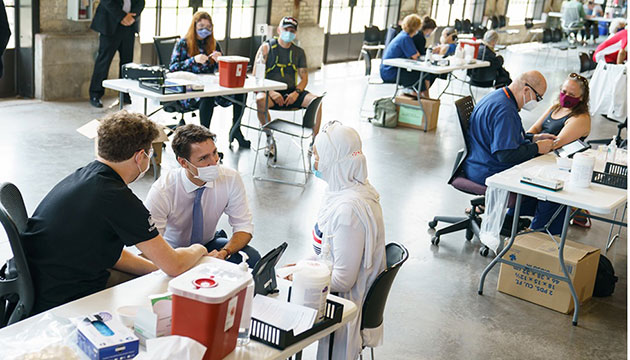(This is Part 33 of Dr. Pagtakhan’s column Medisina at Politika in Pilipino Express, August 1, 2021.)
[Editor’s Note: In February 2020, CF Net started publishing Dr. Rey Pagtakhan’s column, Medisina at Politika, on COVID-19. Now on Part 33 of his running commentary, Dr. Pagtakhan’s column has kept the Filipino community and other CF Net readers continually informed about 1) the pandemic and its impact, 2) the scientific advances on drugs and vaccines, and 3) the effectiveness of public health responses, including mass vaccination as a vital step to individual protection and development of community or herd immunity.]
Winnipeg – Three waves of the COVID-19 pandemic had come and flattened, but Homo sapiens and SARSCoV-2 have remained at war at community battlefields scattered locally, nationally and internationally. Cumulative counts of ill health and deaths in Canada stand at over 1.43 million cases and 26,000 deaths, respectively.
Globally, the cumulative number is almost 196 million cases and over 4 million deaths. This week’s number compared to the previous week showed an 8% increase of new cases and a 21% increase in deaths. “If these trends continue, the cumulative number of cases could exceed 200 million in the next two weeks,” says theWorld Health Organization (WHO Weekly Epidemiologic Report. July 27, 2021).
The world, it seemed, was not prepared when the virus arrived in December 2019. Worse, some political leaders actively worked against scientists and scientific data. Myths and misinformation about the disease and its catastrophic scope emerged. Hopelessness deepened.
Then, science triumphed. Safe and efficacious vaccines have been developed with speed and due diligence. The ensuing mass vaccination campaigns that started a little over half a year ago in December 2020 have since significantly reduced the acquisition of new cases, the need for hospitalization and intensive care units, and the magnitude of deaths, and helped attenuate the gravity of the pandemic in Canada and around the developed world.
 Prime Minister Justin Trudeau visits Pfizer Manufacturing facility in Brussels, Belgium [Source: Photo by Adam Scotti. Prime Minister’s Office. June 15, 2021.]
Prime Minister Justin Trudeau visits Pfizer Manufacturing facility in Brussels, Belgium [Source: Photo by Adam Scotti. Prime Minister’s Office. June 15, 2021.]
Mixed developments in the metrics of progress and easing of public health measures
But the last half-month, however, has shown mixed developments in the metrics of progress globally and in certain areas with our southern neighbour where “nearly two-thirds of US counties have high or substantial transmission of Covid-19” due in large part to the Delta variants so much so that its Centers for Disease Control and Prevention (CDC) has urged vaccinated people in those areas to resume wearing masks indoors in public areas. Said CDC Director Dr. Rochelle Walensky: “It is not a welcome piece of news that masking is going to be a part of people’s lives who have already been vaccinated.” (Kaitlan Collins et al. CNN News. July 27, 2021).
Meanwhile, in Canada, provinces like Alberta, Saskatchewan, British Columbia and New Brunswick have essentially lifted all public-health measures, noticeably travel restrictions and mask mandates, before the virus is completely under control.
Understanding the characteristics of Delta variants and effectiveness of full vaccination
The original SARSCoV-2 or COVID-19, like all viruses, is constantly mutating. Eleven have evolved since the start of the pandemic, but only four have been variants of concern (VOC). That is, they have actually demonstrated any or all of the following properties: 1) increased transmissibility, 2) increased disease severity, 3) ability to escape immunity, and/or 4) ability to escape our diagnostics. They are named ‘variants of interest’ if their genetic mutations are only compatible, but not yet actually shown, with at least one of these properties; they are named ‘variants of consequence’ if they cause severe disease in fully vaccinated individuals, would require us to change our vaccines, and are missed by diagnostic tests.
Most mutations actually harm the virus. And many more are neutral. Rarely, however, mutations are advantageous to the virus. Such rare mutations would take over the original and other strains.
The Delta variant is the most threatening VOC to date. Why? It is a super spreader, that is, an infected person infects more than one person (R-value is 1.48). This has been the most recent observation in Alberta where the disease is once more on the rise (CBC News. July 26, 2021).
Observed Dr. Angela Rasmussen of the Vaccine and Infectious Disease Organization at the University of Saskatchewan: "If people are shedding 1,000 times more virus, the probability that a close contact will be exposed to an infectious dose is much higher. If people become contagious more quickly after exposure, they can have more opportunity to infect others." These define the characteristics of this variant – greater viral shedding from an infected person, faster replication rate, and a reduced incubation period in the infected. These translate to Delta's increased infectiousness and transmissibility.
Thus, it has taken over the original or ancestral version. It circulates in areas of the world least vaccinated. In fact, it has spread to more than 100 countries and has become the most dominant variant, especially in parts of the country where vaccination rates are low as shown in the recent resurgence in the US. Thus, the Delta variant story also highlights the need for global vaccination.
“The rate of mutation in SARS-CoV-2 hasn’t changed,” wrote Dr. William Moss, Executive Director of the International Vaccine Access Center at Johns Hopkins Bloomberg School of Public Health.“It’s just that we’re giving the virus more opportunities to mutate and evolve more transmissible variants, especially with these big surges in cases where there are many unvaccinated people. It becomes an amplifying cycle: you get a more transmissible variant that then causes more infections and that gives that variant more opportunity to mutate and evolve again.”
“There are also evolutionary constraints on how much it can mutate in ways beneficial to the virus,” he continued. “Some mutations are evolving to help the virus bind more tightly to our host receptors. But that’s where vaccines are also targeted. That’s where these evolutionary constraints come in. The spike protein in the virus can’t change too much to escape our immune responses because if it does it won’t bind to our host cell receptors. Maybe it can evolve to bind a little more tightly, but it can’t completely change, or it won’t be able to bind. By being fully vaccinated you’re getting more antibodies in both magnitude and diversity. You are diversifying your immune response so that it can attack different parts of the virus with more antibodies and immune cells.”
Reportedly, two doses of the Pfizer mRNA vaccine gave 88% effectiveness against symptomatic but not necessarily serious disease with the Delta variant and 96% effectiveness at preventing severe disease or hospitalizations. After only a single dose, efficacy was much lower – 33% -- against symptomatic disease. Hence, the importance of full vaccination with the two-dose regimen.
Vaccination status in Canada
As of July 27, 56.25 percent of the total Canadian population have been fully vaccinated, that is,
21,377,946 residents (56.25% X 38,005,238 Canadian population). Conversely, 16,627,292 have yet to be fully vaccinated.
When we look at the proportion of fully vaccinated among the eligible population only – those over 12 years for whom vaccines are approved for use – the figure rises to 63.99%. This means 24,319,552 Canadians are protected, but 13,685,686 remain still unprotected. Add back to the latter figure the number of children for whom no vaccine is yet available (approximately 6 million) and the non-vaccinated group increases in numbers close to 20 million. This swath of the population is a fertile ground for infection and transmission. And when we look at age sub-groups within the overall vaccinated group, we would observe disparities in vaccination rates.
Complicating the current situation is the extremely low vaccine coverage - less than 2.00% among the poor and middle-income countries’ populations in the world which, with the jet travel, has to be taken into account when we ascertain Canada’s vulnerability.
Back to Canada – to my home province of Manitoba – vaccine uptake across the province is uneven, with first-dose rates varying from a high 66% to a low 20.7% in some districts.
To sum up, the vaccine coverage in Canada and in the world to date makes the country still very much vulnerable to the Delta.
Observed Dr. Joss Reimer, medical lead of Manitoba's vaccine task force: "We haven't yet hit the point of that textbook herd immunity, where we have so much protection that the virus can't circulate. The province must reach a minimum of vaccinating 80 per cent of eligible people to achieve herd immunity. This goal was set in the early phase of the pandemic. A higher goal is likely required now in light of the more contagious Delta variants. When the fourth wave of the pandemic arrives — likely to happen in the fall — it will hit hardest in areas with low vaccine uptake.” (CBC Man. Information Radio. July 27, 2021).
Makings of a 4th pandemic wave
Indeed, the makings for a fourth pandemic wave this Fall have been raised and may become inevitable in Canada and around the world. The following scenarios could spark another resurgence: 1) the Delta variants continue their virulent spread; 2) the vaccination rates plateau much below 90% of the total population in segments of the country; 3) re-opening of national borders to international travels; and 4) low and middle-income countries continue to struggle to receive their vaccine supply.
Compounding scenarios could include 1) reopening in the Fall of schools and colleges without requiring full vaccination for all; 2) unavailability of approved vaccines for children under 12 years old; 3) public health measures failing to reckon with the intermingling of non-vaccinated and vaccinated populations in designated settings prone to crowding and large gatherings; and 4) clear protocols for safety in healthcare and related settings.
 Prime Minister Justin Trudeau visits a vaccine clinic at Lansdowne Park, Ottawa on July 2, 2021[Photo by Adam Scotti – Prime Minister Office]
Prime Minister Justin Trudeau visits a vaccine clinic at Lansdowne Park, Ottawa on July 2, 2021[Photo by Adam Scotti – Prime Minister Office]
What would prevent a possible fourth pandemic wave?
The following considerations have been advocated:
- Raise the vaccination rate with speed. We cannot risk having a third or fourth of non-vaccinated college and university students join their peers in every classroom and lecture hall. Also, hastening the speed to full vaccination this August before people have to stay indoors would be ideal.
- Make vaccination mandatory in certain designated settings that can expect greater and longer contacts. It has been accepted practice in Canada to have mandatory vaccination against a list of infectious diseases for school-age children. Healthcare, long-term care homes, and child care centers can reasonably demand of staff and visitors proof of vaccination to protect them and the people entrusted to their care.
- Issue vaccination certificates. Proof of vaccination status would be reasonable to ask were we to prevent serious outbreaks in settings that invite large crowds and longer contacts.
- Keep using the face mask. At least when indoors and gathering closely.
- Enhance specific communication messages to persuade the vaccine-hesitant. Specific approaches are needed since the reasons for hesitancy are varied and include:1) suspicious of vaccine science, 2) non-acceptance of self-vulnerability, 3) distrust of government messaging, 4) severity and seriousness of acute side effects, 5) long-term safety concerns, 6) lack of full confidence in the novelty and speedy development of mRNA vaccine technology, 7) needle-related phobia, 8) severe allergies to the vaccine components, 9) difficulty with physical access, 10) mixed competing messages from government bodies 11) just don't see the point if shown with antibodies from prior infection, and 12) disturbed by the fact that "full approval", not emergency use status, has yet to be given.
- Be more aggressive counteracting disinformation – a reserve for the true anti-vaxxers.
Actually, mitigating the apprehension of a fourth pandemic wave began with the breaking news as this column goes to the press. In a news release July 27, 2021, Prime Minister Justin Trudeau announced “Canada has now received more than 66 million doses of COVID-19 vaccines – enough to fully vaccinate every eligible person in Canada – two months ahead of the original goal of September.” A milestone, indeed! A greater milestone when we succeed in getting them into the arms.
Said the Prime Minister: “The best way to end this pandemic is for everyone to get their shots as soon as they can. Today’s milestone is a clear sign that we are getting closer to this goal.”
Added the Hon. Anita Anand, Minister of Public Services and Procurement:” This milestone was made possible by a true Team Canada effort across government, working closely with a broad range of vaccine suppliers and the immense efforts of dedicated public servants.”
And comes the specific health message from the Hon. Patty Hajdu, Minister of Health: “If you haven’t been vaccinated yet, please make a plan to do so. Our families, communities and small businesses are relying on us to take care of each other and stop the spread. We are regaining so many of the things we enjoy: seeing our families, visiting with friends and going out to eat. Let’s keep going together. Be safe, be sure. Get vaccinated today.”
Full vaccination – what does it achieve?
Aside from protecting oneself from getting the severe disease and being hospitalized or dying, full vaccination achieves the following:
- Prevents others from getting the disease, particularly
- immunocompromised patients receiving cancer chemotherapy, living with HIV or with other underlying medical conditions;
- children younger than 12 years for whom no vaccine is yet approved; and
- vulnerable groups who cannot get vaccinated because of severe allergic reactions;
- Prevents further transmission of the virus infection
- Prevents more mutations and emergence of new variants of concern
- Prevents amplifying the vicious cycle of the pandemic
- Helps ease the community from restrictive public health measures
- Helps achieve population (herd) immunity
- Helps return the country to the normalcy of life and living
In closing, I say
We as a nation should agree to accept the common good. Get vaccinated as soon as possible. Time is of the essence. The Delta variants continue to circulate and would successfully infect a less than fully vaccinated person. And it will continue to super spread.
For the sake of the common good, let us accept reasonable limits to absolute freedom to protect oneself and one’s family and community. Please get fully vaccinated.
We have made great progress. Ending the pandemic is within sight, but the work is not completely finished. If we let our guard down, it could quickly return. We have learned our lessons; let’s use them.
There is no freedom when once more we would fear being confined to bed ill and hoping to recover; being hospitalized for oxygen therapy while gasping for breath, and being admitted to ICU for intubation and attachment to a mechanical respirator in order to breathe and remain alive. There is no freedom in death except the absence of human life.
A fourth pandemic wave is preventable! And we can live our freedom with our loved ones.


![[Source: Kristina Fiore. What's This About Delta Being 1,000 Times More Infectious? MedPage Today. July 23, 2021]](/images/photos/Aug2021/delta.jpg)











